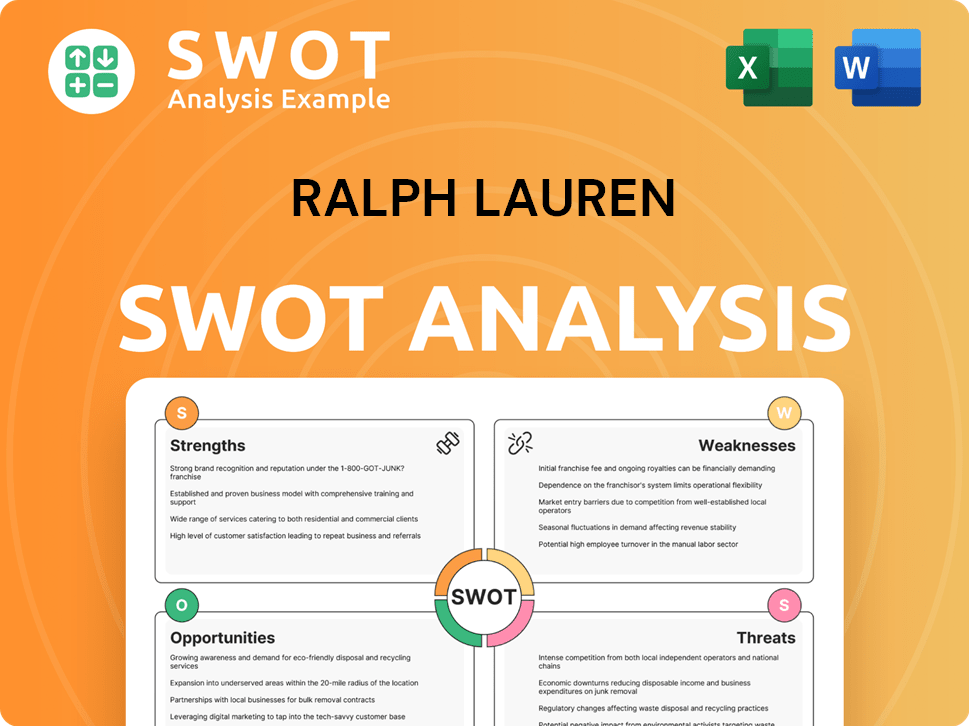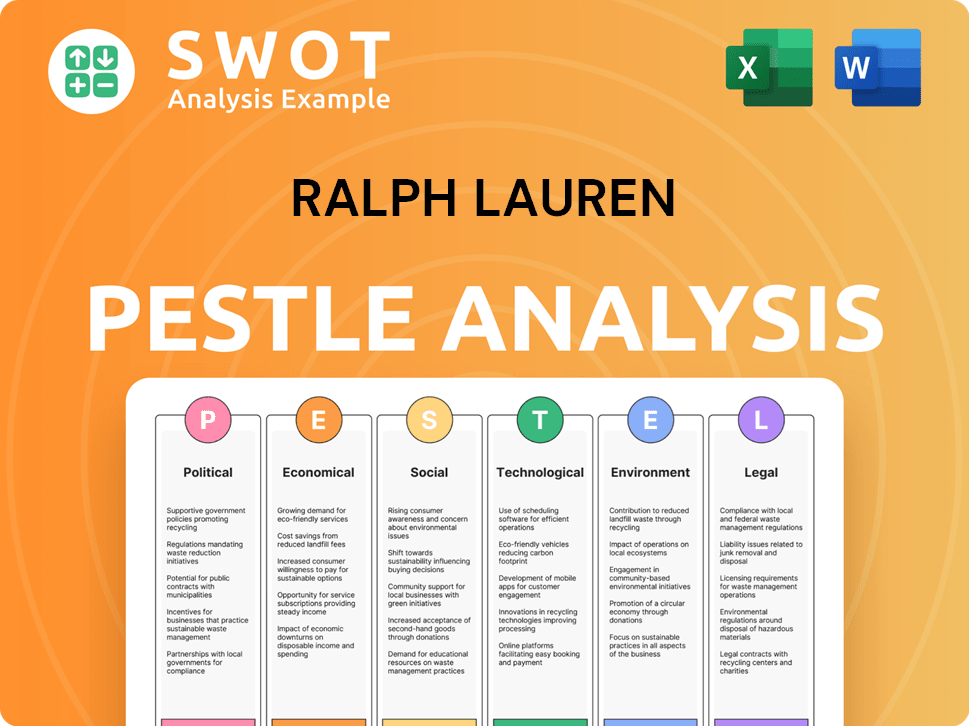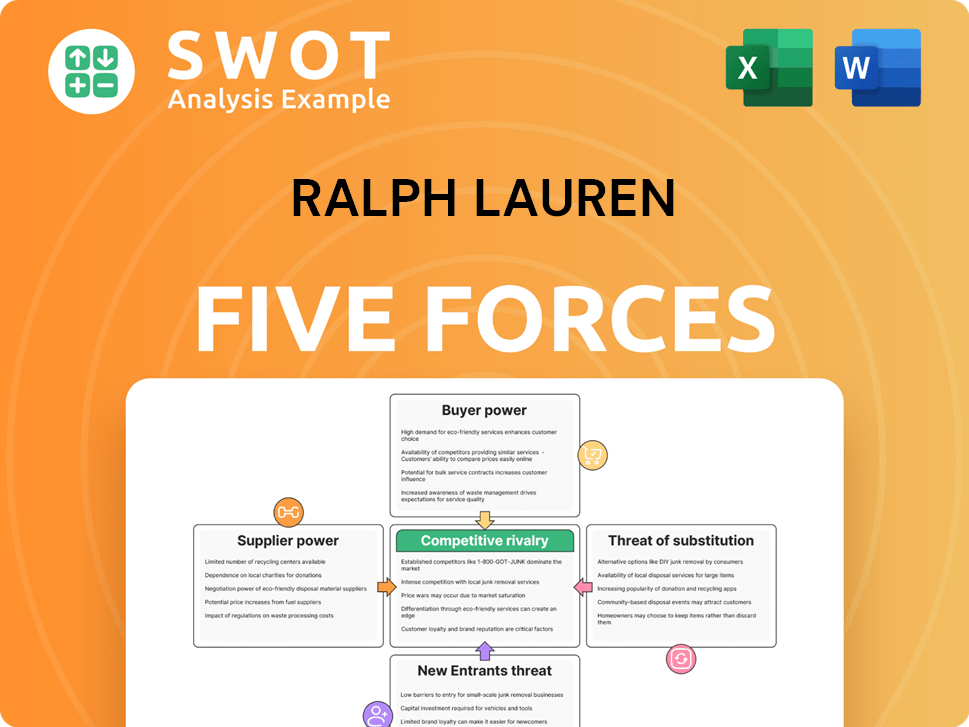Ralph Lauren Bundle
How Does Ralph Lauren Stack Up Against the Competition?
Ralph Lauren, a titan in the luxury lifestyle sector, faces a constantly shifting battleground. Understanding the Ralph Lauren SWOT Analysis is crucial to navigating this complex environment. This analysis dives into the company's market position, key rivals, and the trends shaping its future. We'll dissect the competitive landscape to provide actionable insights.

This exploration of the Ralph Lauren competition will provide a detailed competitive analysis, examining its position within the fashion industry analysis and the luxury brands market. We'll identify Ralph Lauren's competitors and analyze their strategies, market share, and how they impact the competitive landscape of Polo Ralph Lauren. Furthermore, we'll investigate how Ralph Lauren adapts to market competition and its key competitive advantages.
Where Does Ralph Lauren’ Stand in the Current Market?
The Ralph Lauren Corporation holds a significant position within the premium lifestyle segment of the global apparel and luxury goods market. The company's diverse portfolio, including brands like Polo Ralph Lauren, Ralph Lauren Collection, Double RL, and Lauren Ralph Lauren, caters to a wide range of customers, from those seeking accessible luxury to high-end couture. This multi-brand approach allows the company to address various consumer preferences and price points, contributing to its broad market presence.
Geographically, the company has a widespread presence, with operations spanning North America, Europe, Asia, and other international markets. This global footprint reflects a diversified strategy aimed at mitigating risks and capitalizing on growth opportunities in different regions. The company's focus on digital transformation and direct-to-consumer capabilities is a key element of its strategy to enhance customer experience and expand its market reach. For fiscal year 2024, the company reported revenues of $6.4 billion, demonstrating its substantial scale within the industry.
Over time, the company has strategically shifted its positioning, emphasizing a 'Next Great Chapter' strategy focused on elevating the brand, driving targeted expansion, and leading with digital. This includes significant investment in its digital transformation, aiming to enhance its direct-to-consumer capabilities and customer experience. The company's robust financial health, supported by consistent profitability, allows it to invest in brand building, product innovation, and supply chain optimization. While the company maintains a strong foothold in established markets, it continues to explore growth opportunities in emerging markets, particularly in Asia, where luxury consumption is on the rise.
While precise market share figures for 2024-2025 are subject to ongoing market analysis, the company consistently ranks among the top-tier players in its categories. Its strong presence is particularly noticeable in North America and Europe. The company's performance is closely tied to consumer spending trends and the overall health of the luxury goods market.
The brand portfolio includes Polo Ralph Lauren, Ralph Lauren Collection, Double RL, and Lauren Ralph Lauren. Each brand targets different customer segments. The diverse product offerings, including apparel, accessories, home goods, and fragrances, contribute to the company's revenue streams.
The company operates across North America, Europe, Asia, and other international markets. This global presence supports revenue diversification and growth. Expansion in emerging markets, particularly in Asia, is a key strategic focus.
Ralph Lauren reported revenues of $6.4 billion for fiscal year 2024. Consistent profitability allows for investments in brand building, product innovation, and supply chain optimization. The company's financial health supports its strategic initiatives and market competitiveness.
The competitive landscape for Ralph Lauren involves a dynamic interplay of established luxury brands and evolving market trends. Understanding the strategies and market positions of its rivals is crucial for Ralph Lauren's continued success. For a deeper dive into the company's financial model, you can explore the Revenue Streams & Business Model of Ralph Lauren.
Several factors influence Ralph Lauren's market position and its ability to compete effectively. These include brand reputation, product innovation, distribution network, and digital presence. The company's ability to adapt to changing consumer preferences and market dynamics is also critical.
- Brand Image and Heritage: Maintaining a strong brand identity and heritage is essential.
- Product Innovation: Developing new products and collections that resonate with consumers.
- Distribution Channels: Optimizing both retail and digital channels for customer reach.
- Marketing and Promotion: Effectively communicating the brand's value proposition to the target audience.
Ralph Lauren SWOT Analysis
- Complete SWOT Breakdown
- Fully Customizable
- Editable in Excel & Word
- Professional Formatting
- Investor-Ready Format

Who Are the Main Competitors Challenging Ralph Lauren?
The competitive landscape for Ralph Lauren is complex, encompassing a wide array of rivals across various segments of the fashion and luxury goods markets. Understanding these competitors is crucial for assessing Ralph Lauren's market position, identifying potential threats, and formulating effective strategies. A thorough Growth Strategy of Ralph Lauren involves a deep dive into the competitive environment.
Ralph Lauren's competitors range from established luxury brands to fast-fashion retailers, each vying for a share of the consumer's wallet. The competitive dynamics are constantly evolving due to shifts in consumer preferences, technological advancements, and the rise of new business models. This analysis will provide insights into the key players challenging Ralph Lauren and the strategies they employ.
In the fiscal year 2024, Ralph Lauren reported net revenues of approximately $6.6 billion, highlighting the scale of its operations and the significance of its competitive environment. The company's performance is directly influenced by its ability to navigate the challenges posed by its rivals and capitalize on market opportunities.
Direct competitors offer similar products and target the same customer base. These rivals often compete on brand recognition, product quality, and distribution networks.
PVH Corp., the parent company of Tommy Hilfiger and Calvin Klein, is a significant competitor. Tommy Hilfiger often competes in the preppy and casual wear segments, while Calvin Klein targets a more contemporary audience. In 2024, PVH Corp. reported revenues of around $9.7 billion.
Capri Holdings, which owns Michael Kors, Versace, and Jimmy Choo, competes in the luxury and accessible luxury segments. Michael Kors, in particular, offers a wide range of accessories and ready-to-wear products that appeal to a similar demographic as Ralph Lauren. Capri Holdings' revenue in 2024 was approximately $5.2 billion.
Tapestry, Inc., which owns Coach, Kate Spade, and Stuart Weitzman, is another key competitor. Coach competes in the accessible luxury market, while Kate Spade offers a more youthful and feminine appeal. Tapestry's revenue in 2024 was around $6.7 billion.
LVMH Moët Hennessy Louis Vuitton and Kering are major players in the luxury goods market, competing with Ralph Lauren for affluent customers. These conglomerates own a portfolio of high-end brands, including Louis Vuitton, Dior (LVMH), Gucci, and Saint Laurent (Kering). LVMH reported revenues of approximately €86.2 billion in 2023, while Kering reported €19.6 billion.
Indirect competitors may not directly offer the same products but still influence consumer spending habits. These include fast-fashion retailers and online marketplaces.
The fashion industry is dynamic, with constant shifts in consumer preferences and market trends. Ralph Lauren's ability to adapt and innovate is crucial for maintaining its competitive edge. Several factors influence the competitive landscape:
- Market Positioning: Ralph Lauren's brand identity, centered around American luxury and heritage, is a key differentiator.
- Distribution Channels: The company's extensive network of retail stores, wholesale partnerships, and e-commerce platforms is essential for reaching customers.
- Marketing Strategies: Effective marketing campaigns that resonate with the target audience are vital for brand awareness and customer loyalty.
- Sustainability: Growing consumer interest in sustainable and ethical practices is influencing brand strategies.
- Digital Transformation: Leveraging digital technologies for e-commerce, marketing, and customer engagement is increasingly important.
Ralph Lauren PESTLE Analysis
- Covers All 6 PESTLE Categories
- No Research Needed – Save Hours of Work
- Built by Experts, Trusted by Consultants
- Instant Download, Ready to Use
- 100% Editable, Fully Customizable

What Gives Ralph Lauren a Competitive Edge Over Its Rivals?
The enduring success of Ralph Lauren stems from several key competitive advantages that set it apart in the fashion industry. These advantages include strong brand equity, a diverse product portfolio, and a robust global distribution network. These factors contribute to its resilience and ability to maintain a leading position in the premium lifestyle segment. A detailed look at these strengths provides insight into the company's enduring appeal and market position.
One of the primary strengths is its powerful brand recognition. The Polo Pony logo and the Ralph Lauren name are globally recognized symbols of classic American style and aspirational living. This recognition fosters strong customer loyalty and enables the company to command premium pricing. This brand strength is a result of decades of consistent marketing, iconic product design, and a carefully curated brand narrative.
Another significant advantage is its extensive and diversified product portfolio, which includes apparel, accessories, home furnishings, and fragrances. This diversification helps spread risk and caters to various lifestyle needs and price points. The company's global distribution network, encompassing retail stores, e-commerce platforms, and wholesale partnerships, provides broad market reach.
The instantly recognizable Polo Pony logo and the Ralph Lauren name represent classic American style. This strong brand equity fosters customer loyalty and allows the company to maintain premium pricing. The brand's consistent marketing and iconic designs have built a legacy that resonates globally.
Ralph Lauren offers a wide range of products, including apparel, accessories, home furnishings, and fragrances. This diversification reduces reliance on any single category and caters to various lifestyle needs. The broad product range helps to attract a diverse customer base.
The company's extensive distribution network includes retail stores, e-commerce platforms, and wholesale partnerships. This broad reach ensures accessibility to target consumers worldwide. The global presence supports brand visibility and sales growth.
Ralph Lauren's strong supply chain management enables efficient production and timely delivery of its diverse product lines. This efficiency supports the company's ability to meet customer demand. Effective supply chain management is crucial for maintaining competitive advantage.
In the competitive landscape of Polo Ralph Lauren, understanding the company's strengths relative to its rivals is essential. The company's ability to adapt classic styles to contemporary trends ensures its offerings remain relevant to evolving consumer tastes. The company's strategic marketing campaigns and digital engagement further reinforce its position. For more details on the ownership structure, consider reading about Owners & Shareholders of Ralph Lauren. These competitive advantages are continually leveraged through strategic marketing campaigns, digital engagement, and collaborative partnerships, reinforcing Ralph Lauren's position as a leader in the premium lifestyle segment. As of fiscal year 2024, Ralph Lauren reported net revenues of approximately $6.6 billion, demonstrating its continued financial strength and market presence. The company's focus on design innovation and adapting to market trends ensures its enduring appeal.
Ralph Lauren's competitive advantages include strong brand equity, a diversified product portfolio, and a global distribution network, all of which contribute to its market leadership. These advantages are crucial in the luxury brands market.
- Strong Brand Recognition: The Polo Pony logo and Ralph Lauren name are globally recognized.
- Diversified Product Range: Offers apparel, accessories, home furnishings, and fragrances.
- Global Distribution: Operates retail stores, e-commerce platforms, and wholesale partnerships.
- Supply Chain Efficiency: Manages production and delivery effectively.
Ralph Lauren Business Model Canvas
- Complete 9-Block Business Model Canvas
- Effortlessly Communicate Your Business Strategy
- Investor-Ready BMC Format
- 100% Editable and Customizable
- Clear and Structured Layout

What Industry Trends Are Reshaping Ralph Lauren’s Competitive Landscape?
The competitive landscape for the company is shaped by significant industry trends, presenting both challenges and opportunities. The shift towards digital commerce, consumer preference for sustainability, and global economic conditions are key factors. Understanding these elements is crucial for assessing the company's position and future prospects.
The fashion industry is dynamic, with evolving consumer behaviors and market dynamics. This requires continuous adaptation and strategic foresight to maintain a competitive edge. The company must navigate these complexities to ensure long-term success and growth in the luxury market.
Digital commerce continues to be a major driver, necessitating investments in e-commerce platforms and data analytics. Consumer demand for sustainability and personalized experiences is rising. Economic factors like inflation and potential recessions can impact spending on luxury goods. The company must adapt to these shifts to stay competitive.
Maintaining brand relevance amidst changing fashion cycles is a key challenge. Intensifying competition from established and emerging brands also poses a threat. Supply chain disruptions and rising production costs add further complexities. The company needs to strategically address these challenges to ensure sustained growth.
The growing luxury market in Asia, particularly China, offers significant growth potential. Leveraging data analytics and AI can optimize various aspects of the business. Innovation in sustainable materials and processes can enhance brand appeal. Strategic collaborations and acquisitions can facilitate market expansion. These opportunities can drive future success.
Adapting the brand narrative and embracing digital transformation are critical. Prioritizing sustainable practices is increasingly important. These actions are essential to maintaining a competitive edge and ensuring resilient growth. The company's ability to adapt will determine its future success.
The Marketing Strategy of Ralph Lauren must consider its position relative to competitors in the luxury and apparel markets. Key rivals include brands like LVMH (Louis Vuitton Moët Hennessy) and Kering, which own several luxury brands. Fast fashion brands also impact the competitive landscape.
- The luxury market is expected to grow, with Asia being a key region for expansion.
- Digital transformation and sustainability are crucial for future success.
- Understanding the competitive landscape is essential for strategic decision-making.
- Adapting to consumer preferences and market dynamics is critical for long-term growth.
Ralph Lauren Porter's Five Forces Analysis
- Covers All 5 Competitive Forces in Detail
- Structured for Consultants, Students, and Founders
- 100% Editable in Microsoft Word & Excel
- Instant Digital Download – Use Immediately
- Compatible with Mac & PC – Fully Unlocked

Related Blogs
- What are Mission Vision & Core Values of Ralph Lauren Company?
- What is Growth Strategy and Future Prospects of Ralph Lauren Company?
- How Does Ralph Lauren Company Work?
- What is Sales and Marketing Strategy of Ralph Lauren Company?
- What is Brief History of Ralph Lauren Company?
- Who Owns Ralph Lauren Company?
- What is Customer Demographics and Target Market of Ralph Lauren Company?
Disclaimer
All information, articles, and product details provided on this website are for general informational and educational purposes only. We do not claim any ownership over, nor do we intend to infringe upon, any trademarks, copyrights, logos, brand names, or other intellectual property mentioned or depicted on this site. Such intellectual property remains the property of its respective owners, and any references here are made solely for identification or informational purposes, without implying any affiliation, endorsement, or partnership.
We make no representations or warranties, express or implied, regarding the accuracy, completeness, or suitability of any content or products presented. Nothing on this website should be construed as legal, tax, investment, financial, medical, or other professional advice. In addition, no part of this site—including articles or product references—constitutes a solicitation, recommendation, endorsement, advertisement, or offer to buy or sell any securities, franchises, or other financial instruments, particularly in jurisdictions where such activity would be unlawful.
All content is of a general nature and may not address the specific circumstances of any individual or entity. It is not a substitute for professional advice or services. Any actions you take based on the information provided here are strictly at your own risk. You accept full responsibility for any decisions or outcomes arising from your use of this website and agree to release us from any liability in connection with your use of, or reliance upon, the content or products found herein.